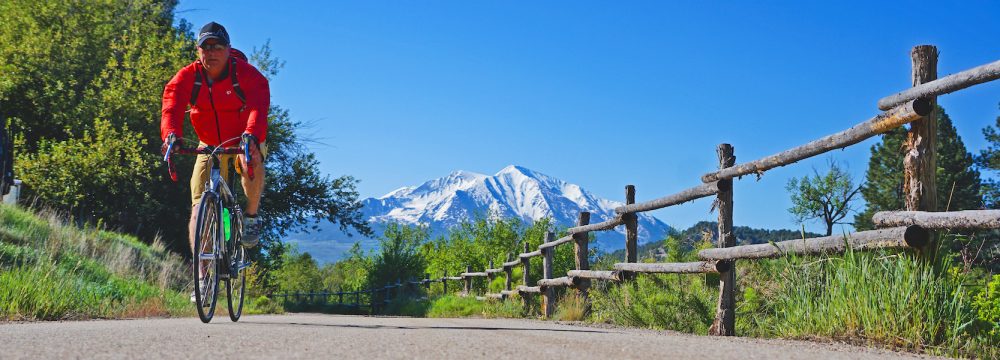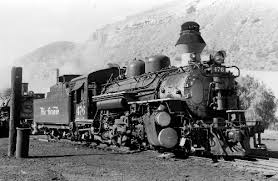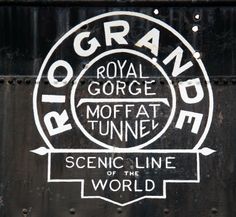
Colorado Rio Grande Trail: History from Grand Railroad to Rail-Trail
Transcontinental Bridge Between Colorado and Utah
Do you know the history behind the popular Colorado Rio Grande Trail? Founded in 1870, the Denver & Rio Grande Railroad (D&RG) made its first tracks from Denver to Colorado Springs, but eventually expanded across the Rockies into Utah. The railroad started as a 3-ft narrow gauge line running south from Denver. Founder General William Jackson Palmer was inspired by a narrow gauge railway he observed in Wales a few years earlier. Turned out to be a wise decision because narrow gauge was more affordable to construct and better suited to handling the mountainous regions of the Southwest. The D&RG went through a number of names and mergers over its lifespan, but the moniker Rio Grande stuck. It officially became the Denver & Rio Grande Western Railroad in 1920, and later merged with the Southern Pacific Railroad. During its lifetime, it served mainly as a transcontinental bridge line between Denver and Salt Lake City, Utah. In addition, it was also a major origin of coal and mineral traffic from throughout the “Mineral Belt” in the high country of central Colorado.
Rocky History of the Rio Grande Trail
The Rio Grande changed ownership a number of times, merged and separated and was even the backdrop for some shootouts as different railroad companies fought in a war for right of way from 1877 to 1880. At one point, the D&RG treasurer even paid off some defenders to stop a gunfight. A court decision called the Treaty of Boston finally settled the right of way, with the Rio Grande paying $1.4 million for a line going through the Arkansas River’s Royal Gorge. Exorbitant at the time, this gave D&RG access to the lucrative mining district of Leadville, and eventually to Utah.
“Through the Rockies, Not Around Them”
The Rio Grande quickly became the standard bearer for mountain railways and lived up to its motto of Through the Rockies, not around them. In fact, the Rio Grande operated the highest mainline rail line in the United States, traveling over Colorado’s Tennessee Pass (10,240 ft), and on other famous routes such as the Moffat Tunnel and the Royal Gorge. In its heyday of the mid-1880s, the Rio Grande had the largest narrow gauge railroad network in North America: 2,783 miles of track connecting Colorado, New Mexico and Utah. Just like the independent pioneers, the Rio Grande maintained its independence right up into 1983, when it operated the Rio Grande Zephyr, the last private intercity passenger train in the U.S. running from Denver, Colorado to Ogden Utah.
Rio Grande Railroad in the Roaring Fork Valley
The Rio Grande first reached Aspen in 1887 as it raced the Colorado Midland Railroad to service the Silver Mines that were popping up on Ajax Mountain, the site of current day Aspen Ski Area. In the waning years of the railroad, service was ceased to Aspen in 1968. Limited ore load out trains operated to Woody Creek Junction until 1986. In January of 1991, the final Geneva Steel-bound coal trains stopped loading at the Mid-Continent Coal & Coke company in Carbondale. Between 1991 and 1995, service was very infrequent south of Glenwood Springs, delivering beer to a distributor about 5 miles from the main line along the Colorado River. In 1995, all operations ceased on the Aspen Branch of the D& RG. This created the opportunity that would become the beautiful trail we know today, as the Colorado Rio Grande Trail.
Rail-Trails and the Rebirth of the Rio Grande Trail
Around the same time as the Rio Grande’s final run through the Rockies, an organization was founded that would result in the rebirth of not only the Rio Grande but thousands of abandoned railroad lines. In 1986, the Rails-to-Trails Conservancy (RTC) was created by a group of walking and biking enthusiasts, railroad history buffs, conservation and parks groups, and active-transportation activists in Washington, DC. Since its inception 30 years ago, RTC has worked tirelessly across the United States supporting the development of thousands of miles of rail-trails and multi-use trails. RTC blends national policy advocacy and research expertise with on-the-ground trail development.
“In 1965…Rails-to-Trails was still a highly localized movement; people said, ‘We’ve got an abandoned railroad track, so let’s use it.’ Only gradually did there emerge a realization that America desperately needs a national trails system, and that unused rail corridors are the perfect backbone for that network.” —Peter Harnik, RTC Co-founder
The Conversion of the Rio Grande Trail into the next potential Hall of Fame Rail-Trail
The rail-trail movement inspired the conversion of a 42-mile stretch of the Rio Grande railroad into a car-free, mostly paved, multi-use path from Aspen to Glenwood Springs. The right-of-way corridor was purchased in 1997 with a combination of funding by local governments, Great Outdoors Colorado, Pitkin County Open Space and Trails, and the Colorado Department of Transportation. Today, the Rio Grande Trail stands as one of the best rail-trails out there–nominated for RTC’s Rail-Trail Hall of Fame in 2016 and the RTC trail of the month in April 2016.
Learn what’s so special about the Rio Grande Trail for biking and why its featured as part of two of our Colorado bike tours (Cycle Colorful Colorado and Kick Some Pass).



